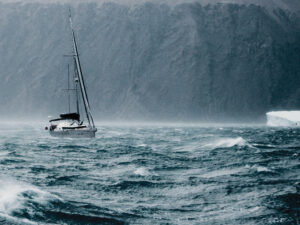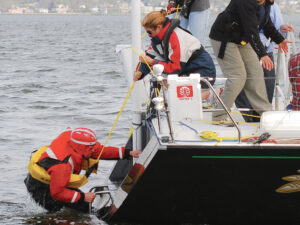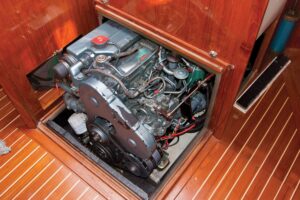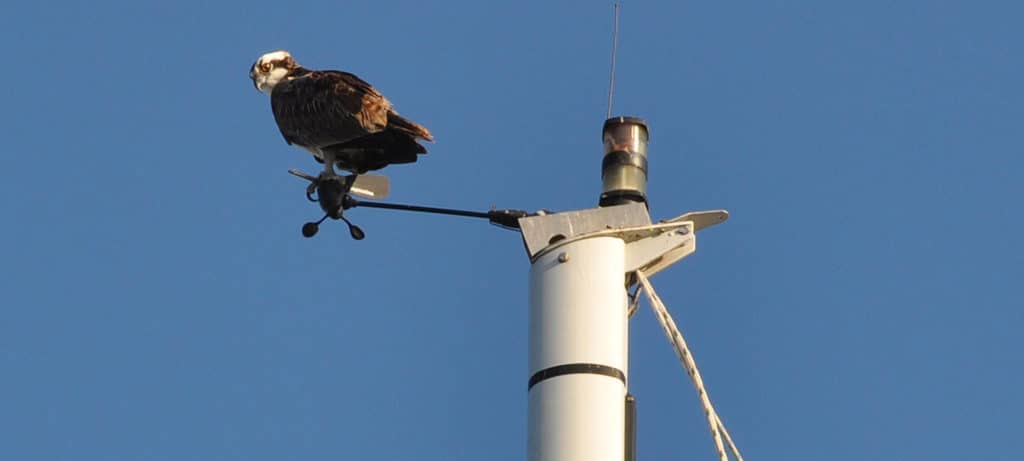
There are surely few things more upsetting to a proud boat owner than arriving for a nice weekend only to find the decks covered in bird droppings. This happened to us on a regular basis because the marina where we kept Britannia is next to a public park with lots of trees. These trees are full of blackbirds, starlings, crows and pigeons, which roost and feed on the berries, then fly over and do their dirty work all over the boats. It’s a serious problem at this marina because, if the acidic excrement is not washed off, decks can be permanently stained; paintwork and varnish will discolor; and canvas, sails and ropes will rot.
The obvious answer is to try and deter the pesky critters from landing on your boat in the first place, but this is easier said than done, especially on a sailboat with so many perfect perches. Britannia is a schooner, which has twice the potential landing sites as a sloop, including a triatic stay between the masts.
An initial online search for “bird deterrents for sailboats” brings up a wide variety of products, all of which claim to do the job. There are also independent reports and forum threads dealing with specific products, which are not quite so effervescent as some manufacturer’s claims. Products range from the ubiquitous plastic owl (which I have actually seen a real bird sitting on) to sophisticated devices such as an imitation peregrine falcon kite designed to swoop in the breeze from a 15-foot pole.
Many devices must be removed when you want to go sailing. You obviously can’t sail with something whizzing around on your main or mizzen boom, so this type of thing needs to be easily removable. Other products, which fit on mastheads, radomes, davits or spreaders, can be left in place.
I sent a letter to 10 manufacturers, asking if they were interested in supplying any devices they had for sailboats, and received products from five. It can be quite complex and expensive to decide which ones you need to cover each area of your boat. Here’s how the products worked for me.
Beginning at the top and working down:
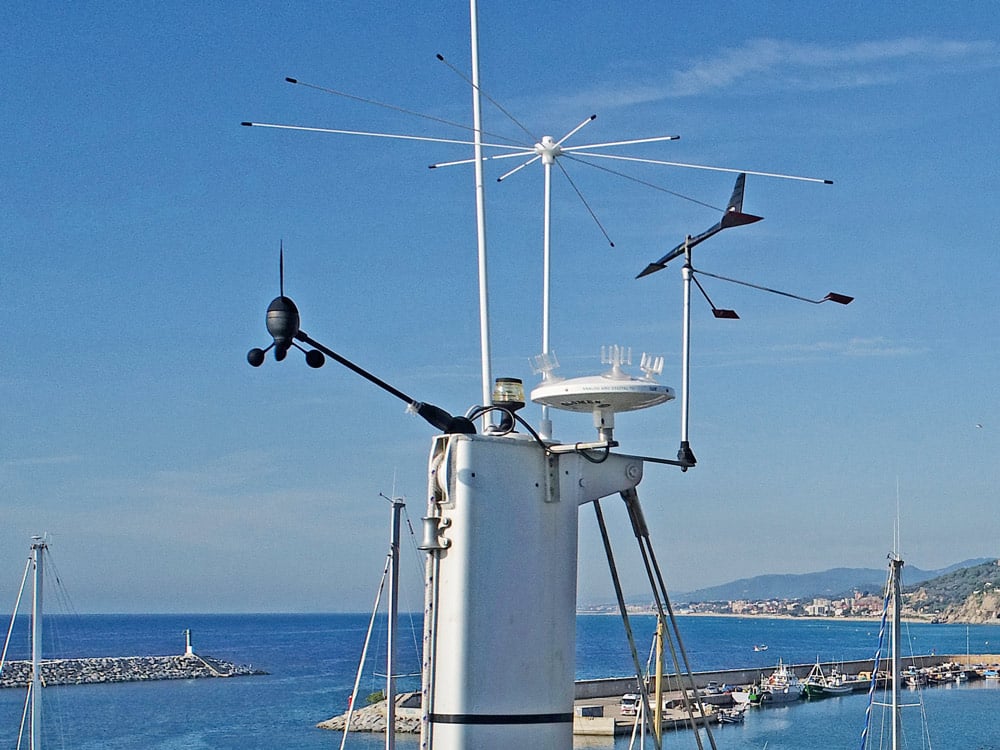
The Masthead
Mastheads are fairly easy to protect. StopGull has a product called the Topmast, which is basically a series of spiky rods that rotate freely and unbalance a bird trying to land. The rods can be adjusted in height to clear a Windex, and if there is an antenna, rods can be removed to still allow the device to move a little. Something similar could also be homemade from stainless wire and attached to the top of a mast.
A different concept is the Bird Spider 360, which is made by Bird-B-Gone. It consists of a series of thin, wobbly wires hanging like spider legs. These prevent birds from landing, but are not compatible with wind instruments. Both devices stop birds landing on mastheads.
So far, so good.
Triatic Stay
One device I tried for my 14-foot-long triatic wire was a predatory-bird decoy made by StopGull. This is a 24-inch-wingspan peregrine falcon kite, flying in a very realistic manner from a length of nylon line off a 15-foot fiberglass rod. I hoisted it to the top of my mainmast using the gantline, which ensured it remained above the masthead and didn’t tangle with the triatic. The kite flew in even a slight breeze, and did deter birds from coming near, even the osprey. However, I don’t know how long it will last in a good blow. It was also difficult to hoist and lower in any wind.
Gullsweep supplied a rotator, which hangs upside down. I hoisted it between my masts, hoping to get it high enough to frighten birds off the triatic, where I think it would have been quite effective, but my wind generator was in the way. Any two-masted rig would need a halyard from each mast, along with a deck tether. Then it would be quite easy to hoist up and down. The problem, of course, with all wind-driven devices is that they are useless in a flat calm.
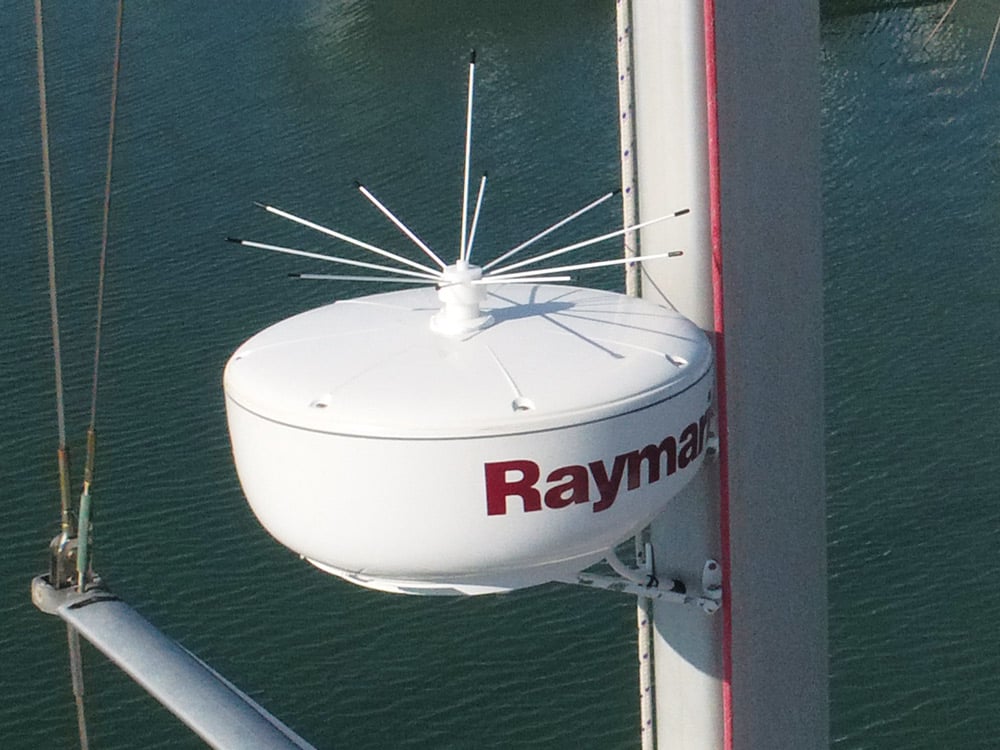
Radomes and Flat TV Antennas
Here I used one “spiky rod” and one “spider.” I didn’t want to drill into the top of either platform, so I glued them on with epoxy. They were both effective in stopping birds landing, but I wonder if they will still be there after the next big blow.
Spreaders
My mainmast spreaders are each 6 feet long, and the foremast spreaders are 5 feet, which is quite a length to protect. StopGull offered a wire to be attached to the cap shroud about 3 inches above the spreader and held taut at the mast by bungee cord. This prevented birds from landing, but bungee cord doesn’t hold up long in the Florida sun. A stainless spring would be more resilient.
A second device made by Bird-B-Gone was a series of plastic spikes fastened all the way along the spreader with cable ties. This also stopped birds landing. A simple DIY version can be made by using stainless brads sticking up through a plastic strip strapped or glued to the spreader. The brads prick the birds’ feet, and they fly away.
Unless you are very agile (and also brave), you should perhaps employ a professional rigger to install these things. Attaching anything along spreaders requires swinging precariously out along them. However, once installed, they don’t need to be removed.
Booms, with or without Sails or Covers
I found the simplest device to be long rotating arms. These are available in 6-foot and 8-foot diameters and are mounted with adjustable straps on a bare boom, or over a sail/cover. Straps are easily unclipped when you want to go sailing. They are available from Bird-B-Gone, StopGull and Gullsweep. They rotate in even a slight breeze and effectively deter birds landing nearby — but only if there is a breeze! Bird-B-Gone offers a solar-powered version that works when there is no wind.
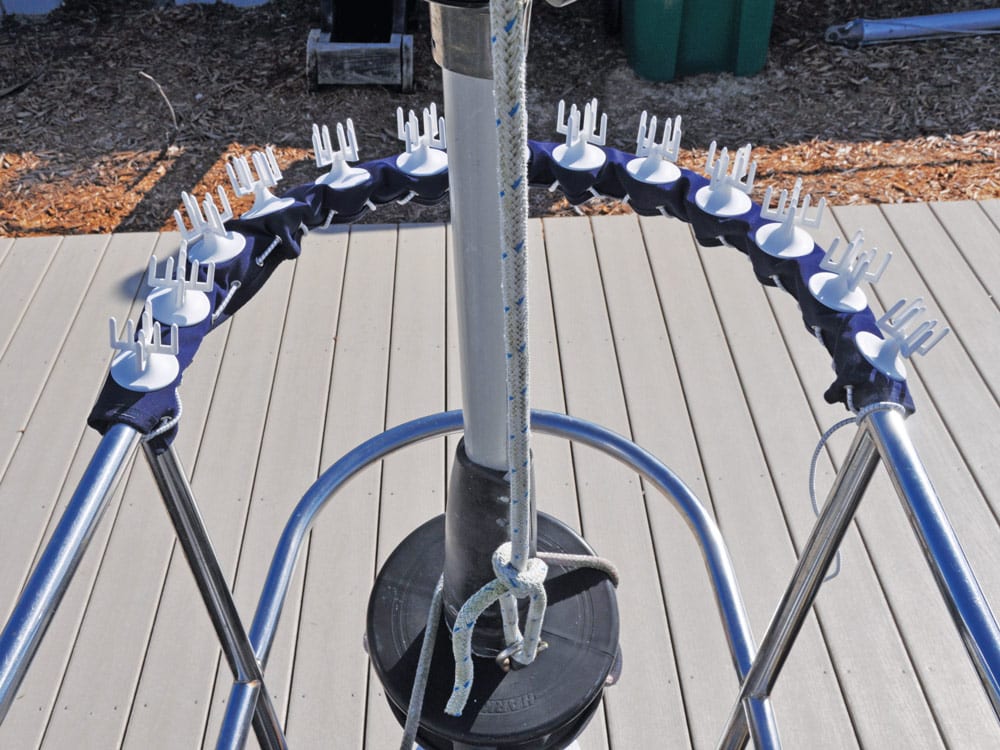
Biminis, Decks and Cabin Tops
If you have clearance above your Bimini, rotating arms would again be an effective deterrent. StopGull offers an adaptor that clamps through a canvas Bimini. If you have a solid cockpit top, or for any hard surface, a “sandbag” adaptor is made to mount a rotator. This is heavy enough to stay in place and works on any flat surface.
I always spread a simple tarp awning over my main boom and Bimini when in port. This protects the boom, the entire Bimini and part of the afterdeck against droppings from on high. Plastic tarps are available in many different sizes and relatively inexpensive. They also protect a canvas Bimini against rain and sun in addition to keeping the cockpit cooler, but they can be tiresome to scramble under. Shadetree Fabric Shelters supplied a very well-made Dacron awning supported by demountable flexible rods passing through it from one side to the other to create an arch, clear of booms and sails. It made the aft section look a bit like a covered wagon, but allowed easy companionway access. The clearance allowed wind to blow through, between the awning and Bimini, and it didn’t flap around like a tarp.
A good rain shower will usually wash bird droppings off awnings, but taking them down and setting them up can be tedious if you sail regularly.
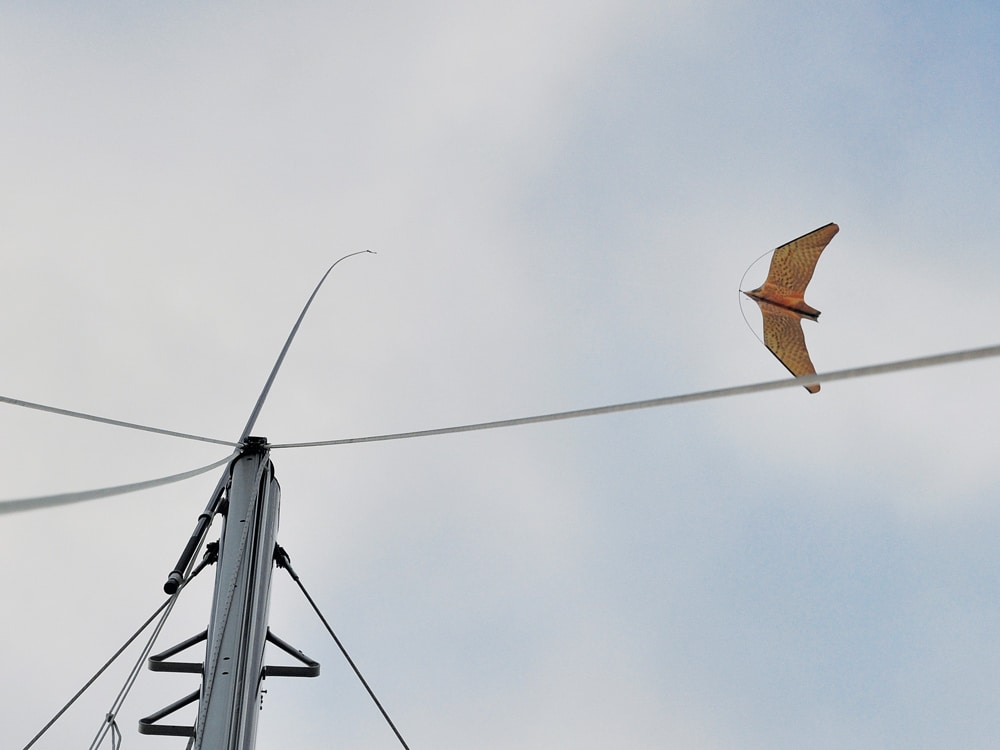
Static devices placed on decks don’t seem to deter birds for long; they quickly realize the owl, eagle or snake is false. It’s things that move irregularly that frighten them away.
One package from Bird-B-Gone contained a headless and tailless black cat. After assembly, which consisted of simply shoving its head on one end and its tail on the other on wobbly springs, it became quite a cute little sprog. I placed it on my deck, and no birds came near it. However, it still didn’t stop them dropping their loads from above, and after a few days, the poor thing began to look like it needed a bath.
Rails and Safety Lines
StopGull makes 3-foot-long canvas strips with plastic candelabra-looking spikes mounted every 3 inches. These rotate and upset a bird’s balance when it tries to land. They can be strapped along a rail, or bow or stern pulpit, and don’t need removing. I fitted one strip on the forward rail at the bow. Fitting them to the sides would have impeded the jib. I fitted two more to my davit arms, which effectively stopped birds landing, including pelicans. They are also available in self-adhesive single units to stick on things such as navigation lights.
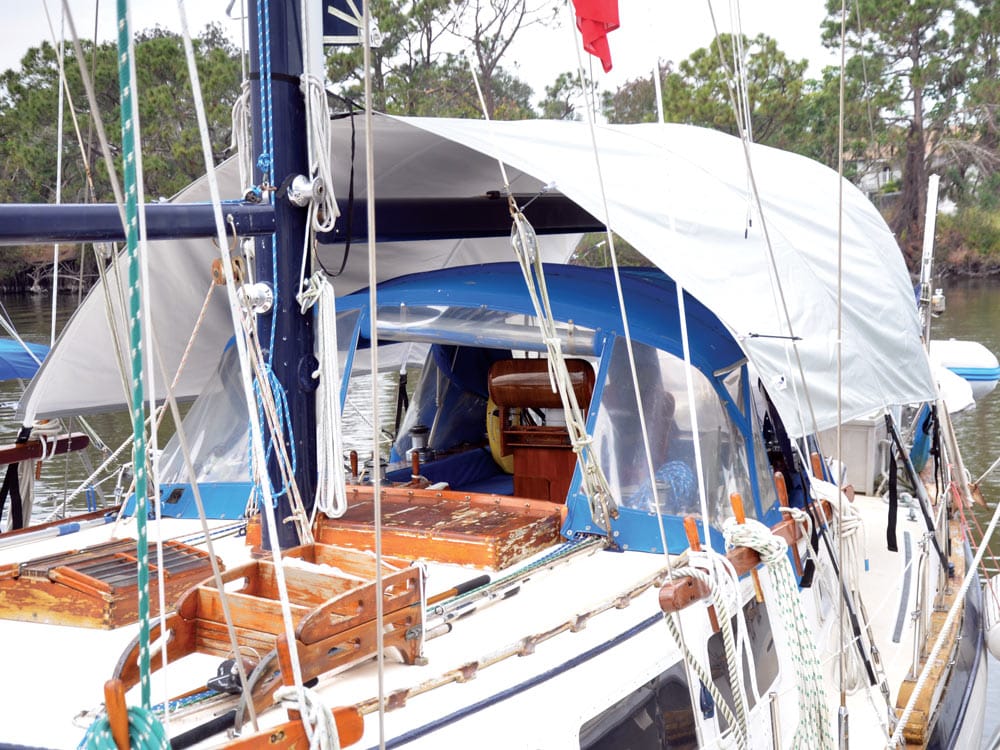
Acoustic Devices
All the above devices only protected sections of a sailboat, but acoustic deterrents claim to cover amazingly large areas, even a complete marina! I tried two very sophisticated-looking units made by Bird Gard and Bird-B-Gone.
A speaker emits different distressed bird calls, which causes birds to flee the area. These can be programmed to upset individual species or rotate through a number of common types. One unit was solar-powered for outside use and sat on the deck. The other had two separate speakers that I ran halfway up my masts on halyards. I tried each unit separately. The calls are quite strident, and Britannia began to sound like an aviary, where the cacophony soon become as annoying as the real bird cries. Volume and duration can be controlled, and they shut off automatically at night when birds are less prevalent. But if you left one of these devices squawking all day, I can imagine there would be complaints — birds or no birds. Bird Gard’s model with separate speakers seemed to be more effective overall, but both units frightened the smaller birds that visited.
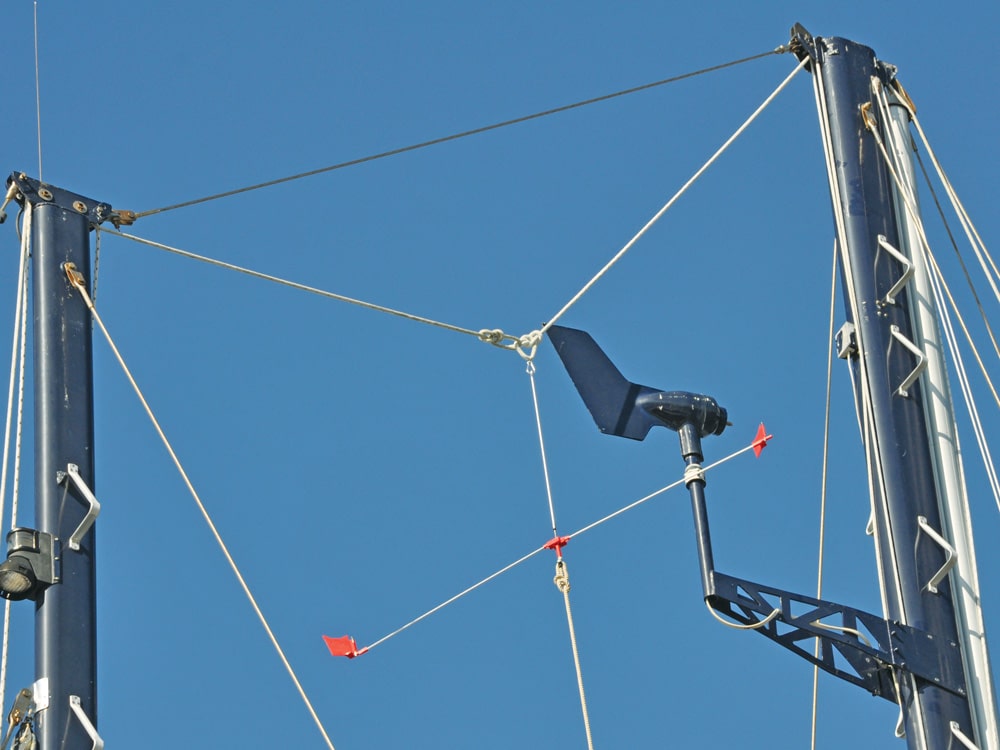
These devices are much more expensive than individual products (in the region of $200 to $400), but upon adding up the cost of all the separate devices needed to protect a sailboat completely, the cost came to about the same.
There are many other products: imitation snakes, the before-mentioned plastic owl and other quite impressive bird decoys, shiny disks which flutter in the breeze, balloons and myriad other things. Some of these struck me as more gimmicky than effective, but I did not test them.
Conclusion
Individual devices can prevent birds from perching on mastheads, spreaders, radars, booms and rails, and these undoubtedly reduce droppings on decks. But birds still manage to cling to rigging wires, even those that are vertical.
The acoustic deterrents are the only things that cover a complete boat and are easy to set up and remove. But even these didn’t stop determined birds from landing during the one- or two-minute intervals between calls, and they definitely are noisy.
I finally came to the conclusion that the only way to keep a sailboat’s decks entirely free from droppings is with awnings, which don’t rely on wind and are also silent.
During this fascinating review, Britannia also attracted much curiosity with all its appendages, especially the flying falcon and spinning arms, which made it look like a drone ready to lift off.
The problem eventually became so annoying that I decided to move Britannia to a different marina. After all, that’s a benefit of having a boat. If you don’t like the locals or the surroundings, you can always move.
Prolific do-it-yourselfer Roger Hughes lives in Florida and is a frequent *CW contributor.*

